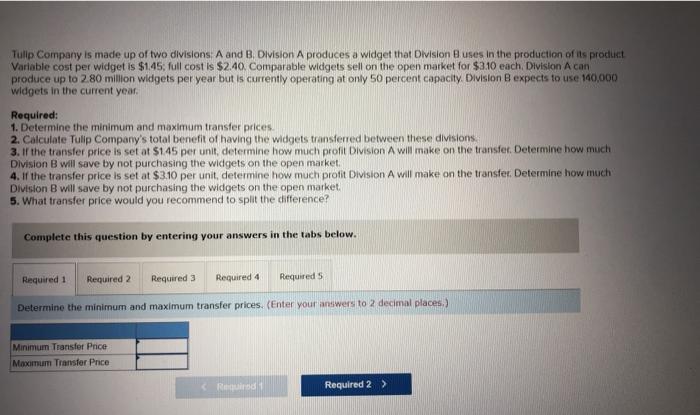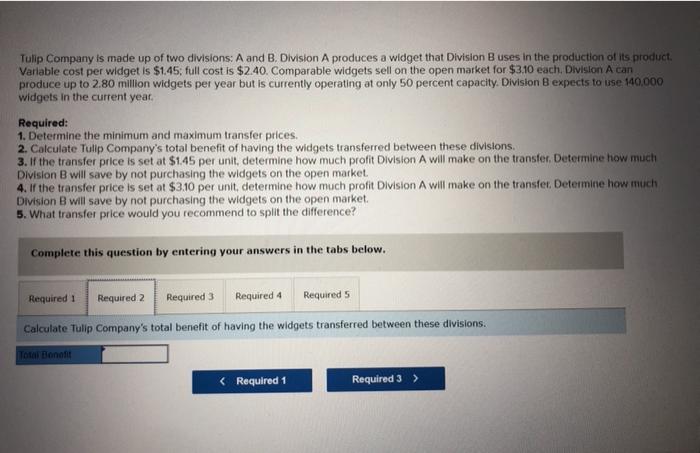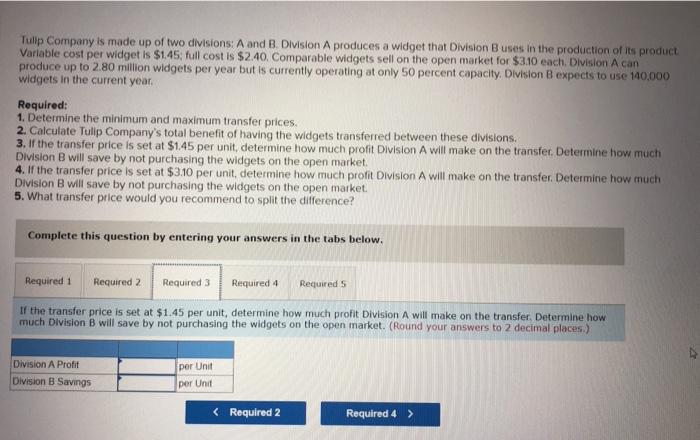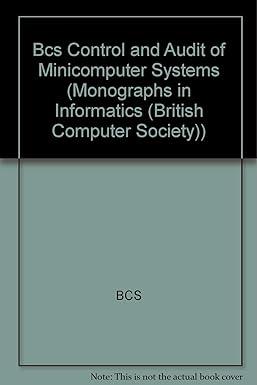Tulip Company is made up of two divisions A and B Division A produces a widget that Division Buses in the production of its product Variable cost per widget is $1.45. full cost is $2.40 Comparable widgets sell on the open market for $3.10 each Division A can produce up to 280 million widgets per year but is currently operating at only 50 percent capacity. Division B expects to use 140,000 widgets in the current year Required: 1. Determine the minimum and maximum transfer prices 2. Calculate Tulip Company's total benefit of having the widgets transferred between these divisions 3. If the transfer price is set at $145 per unit, determine how much profit Division A will make on the transfer. Determine how much Division B will save by not purchasing the widgets on the open market 4. If the transfer price is set at $3.10 per unit, determine how much profit Division A will make on the transfer. Determine how much Division B will save by not purchasing the widgets on the open market 5. What transfer price would you recommend to split the difference? Complete this question by entering your answers in the tabs below. Required 1 Required 2 Required 3 Required 4 Required 5 Determine the minimum and maximum transfer prices. (Enter your answers to 2 decimal places.) Minimum Transfer Price Maximum Transfer Price RO Required 2 > Tulip Company is made up of two divisions: A and B. Division A produces a widget that Division Buses in the production of its product. Variable cost per widget is $1.45, full cost is $240. Comparable widgets sell on the open market for $3.10 each. Division A can produce up to 2.80 million widgets per year but is currently operating at only 50 percent capacity. Division B expects to use 140.000 widgets in the current year Required: 1. Determine the minimum and maximum transfer prices. 2. Calculate Tulip Company's total benefit of having the widgets transferred between these divisions. 3. If the transfer price is set at $1.45 per unit, determine how much profit Division A will make on the transfer. Determine how much Division B will save by not purchasing the widgets on the open market. 4. If the transfer price is set at $3.10 per unit, determine how much profit Division A will make on the transfer. Determine how much Division B will save by not purchasing the widgets on the open market. 5. What transfer price would you recommend to split the difference? Complete this question by entering your answers in the tabs below. Required: Required 2 Required 3 Required 4 Required Calculate Tulip Company's total benefit of having the widgets transferred between these divisions. To Be Tulip Company is made up of two divisions: A and B. Division A produces a widget that Division Buses in the production of its product Variable cost per widget is $1.45: full cost is $2.40. Comparable widgets sell on the open market for $310 each. Division A can produce up to 2.80 million widgets per year but is currently operating at only 50 percent capacity. Division B expects to use 140,000 widgets in the current year. Required: 1. Determine the minimum and maximum transfer prices. 2. Calculate Tulip Company's total benefit of having the widgets transferred between these divisions. 3. If the transfer price is set at $1.45 per unit, determine how much profit Division A will make on the transfer. Determine how much Division B will save by not purchasing the widgets on the open market 4. If the transfer price is set at $3.10 per unit, determine how much profit Division A will make on the transfer. Determine how much Division B will save by not purchasing the widgets on the open market. 5. What transfer price would you recommend to split the difference? Complete this question by entering your answers in the tabs below. Required 1 Required 2 Required 3 Required 4 Required 5 If the transfer price is set at $1.45 per unit, determine how much profit Division A will make on the transfer. Determine how much Division B will save by not purchasing the widgets on the open market. (Round your answers to 2 decimal places.) Division A Profit Division B Savings per Unit per Unit









